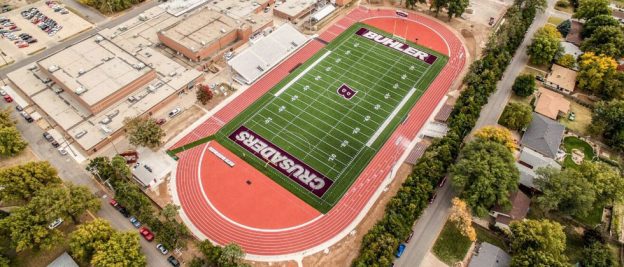How Big Should Your Field’s Dimensions Be?
Planning a new sports field for a community center or school can be tricky if you don’t know how much space you need. Mid-America Sports Construction has the knowledge and experience to help guide you through the process.
Read more to learn about the common dimensions for each sports field and age group then call Mid-America Sports Construction for a quick quote and specific advice on the best field size for your facility.
Football Field Dimensions
High school football fields share the same size as NFL and collegiate fields measuring exactly 120 x 53.3 yards. All football fields have 100 yards of play and two endzones that are 10 yards deep. Though the overall size stays the same there is a slight variation in measurements on the field.
The two sets of hashmark lines that run down the field every five yards have one slight variance between high school, college, and the NFL. The distance between the two sets is wider for high school football players with a measurement of 53 feet and 4 inches. The hash marks for NCAA football are 40 feet apart and just 18 feet and 6 inches apart on an NFL football field.
One other small difference between the NFL and high school football fields is the goalpost dimensions. Every goalpost has the same height of 30 feet. The crossbar stands at 10 feet leaving 20 feet for the posts.
The difference in measurements lies in the width between posts. For high school football, the goalposts are 23 feet and 4 inches apart while the NFL has a more challenging width of 18 feet and 6 inches.
Youth football leagues, like Pop Warner or City teams, are the only time you’ll see a change in how wide or long a football field is.
Youth Football
A youth football field is scaled down to meet the needs of younger players and measures out to 80 x 23.3 yards. The midfield is the 40-yard line and the two endzones are 8 yards deep. You may find a few pop-up fields that are a little bigger or smaller for junior or pee wee teams, but this is the standard youth football field size.
Flag football uses different dimensions featuring a much shorter length and wider width. A flag football field is only 70 yards long but 30 yards wide. It has two 10-yard endzones leaving 50 yards to play the game.
History
The length and width of a football field have been the same since the sport was officially recognized as a professional sport in 1920. One of the major changes to the rules for football fields was the addition of hashmarks. Later other updates were made to how the football field was designed including the location of the goalposts and the materials used for the field.
Mid-America Sports Construction specializes in both artificial and natural grass football fields that meet the NHS, NCAA, and NFL rulebooks. During your consultation be sure to mention the level that intends to use the field to get the best advice on your football field construction project.
Soccer Field Dimensions
A soccer field can be bigger, smaller, or about the same size as an American football field depending on the level. Due to its popularity on an international scale, soccer has several different levels with various regulations on field sizes. From FIFA to youth soccer the field’s dimensions vary for international use to age group.
It’s important to clarify who will be playing at your new soccer field and for what purposes when discussing your project with one of our contractors at Mid-America Sports Construction. The more information you have the better the advice and quote accuracy you’ll receive on your soccer field construction.
FIFA Field Sizes
FIFA’s “Laws Of The Game” booklet mentioned two different field sizes for professional soccer. One is used for standard soccer games, and the other is for international matches. An international pitch is known for having stricter field sizes and dimensions to keep games consistent for players traveling overseas.
All international and standard soccer fields (or football pitches) follow the rules of being either all-natural or artificial grass fields. The only exception for a hybrid system is if the field is marked with artificial lines, but they can’t cause any harm or interference during the game. All soccer pitches also share a midpoint featuring a center mark surrounded by a circle that has a 10-yard radius.
Standard Fields
A standard field, following FIFA’s guidelines, will have a touchline between 100-130 yards. The goal line for these fields is allowed to be between 50-100 yards. As long as the field dimensions meet this requirement (along with rules regarding field marks) it can be used for a standard soccer match. Competitions can further define the field of play as long as they stay within these dimensions.
International Fields
International soccer fields are stricter about their dimensions when following FIFA’s rules on “The Field of Play”. The touchline of an international field needs to be 110-120 yards while the goal line needs to stay between 70-80 yards. Like standard fields, competitions may define the rules further as long as the field of play stays within the stated range of dimensions.
Collegiate Fields
Collegiate Fields have a stricter field of play that allows a short range of 115-120 yards for the touchline and a 70-75 yard goal line. College soccer fields built before 1995 are exempt from this rule but must still maintain a rectangular shape. This is a key point to remember when resurfacing an older soccer field.
The preferred size of a collegiate soccer field is 75 x 120 yards as stated by NCAA (PRXSO_SoccerFieldDiagram). Indoor soccer fields must follow the same guidelines for the field of play.
High School Fields
The National Federation of State High School Associations enforces soccer field dimensions similar to a standard-sized FIFA field. The minimum width for the NFHS soccer field is 55 yards with a maximum of 80 yards. The length, or touchline, should be within 100-120 yards.
Other than the boundaries of the playing field, high school soccer fields share the same measurements as college fields. This includes the field markings used to mark the center field, goalie areas, and goal posts.
Youth Fields
Youth soccer fields have their own sizes based on age groups. Each field allows for a different number of players to be on the field. Some of the youth soccer field sizes you’ll see include dimensions for 9v9, 7v7, and 4v4 games.
Much like the higher playing levels, these fields must be rectangular in shape, and either be all turf or all-natural grass fields. AYSO shares specific rules for each division regarding soccer field sizes, players, and more.
12U Field Dimensions
A 9v9 soccer field is built for 12U soccer teams and allows for 9 players per team including the goalie. The field should have a touchline between 70-80 yards long and a goal line that 44-55 yards wide. The players at this age use a goalpost that is at least 6.5 feet tall, but no more than 7 feet. The goal should also be between 18.5-21 feet wide.
10U Field Dimensions
A 7v7 soccer field is built to accommodate 9U & 10U youth soccer teams. This type of field has a 55-65 yard touchline and a 35-45 yard goal line. These fields are also required to have goalposts that are at least 6.5 feet tall and 18.5 feet wide.
6U Field Dimensions
This soccer field caters to 6U youth players that are only allowed to have 4 players on the field per team. This field should have a 25-35 yard touchline accompanied by a 15-25 yard goal line. The goals can be marked with either tall cones or a post that is 4 feet high. The width between the posts or cones has to be 6 feet.
History
The first standardized soccer field dimensions established in 1937 was a 70 x 100 yard field. Before that, soccer fields ranged between 100 to 200 yards with no clear touch lines. By 1997 FIFA decided that international matches should “be exactly 110 yards long and 70 yards wide” (Big News Network).
The markings we know today (previously marked by flags) were introduced to the game in 1891 and were revised to the modern field markings we see today in 1902. These markings include the touchlines, goal lines, center circles, penalty areas, and halfway lines.
Baseball Field Dimensions
The famous baseball diamond has a few dimensions depending on the age group. The MLB, NCAA, and NFHS have a common measurement of 90 feet between bases.
They also share 60 feet between the home base and the pitcher mound as well as 95 feet between the pitcher mound and the grass line. However, many baseball diamonds vary in the depth of the outfield.
Mid-America Sports Construction has a portfolio of baseball field projects like the NCAA-approved artificial baseball diamond at Kansas State University. We also offer expert experience installing high-quality turf dugouts, batting cages, and bullpens.
Little League Fields
If your baseball field project is intended for your favorite little leaguers, you’ll need a smaller playing field. The basic dimensions for little league baseball feature 60 feet between bases. A little league field has just 46 feet between home base and the pitcher’s mound which is perfect for players 12 and under.
History
The first set of dimensions for a baseball field was laid out by Alexander Cartwright, famously known as the “father of baseball”. Cartwright’s rules were the first to include a regulated field of play. His dimensions stated there should be “42 paces” between each base and were later re-defined as 90 feet between bases by the MLB.
Sports Field Construction
Now that you have a general idea of the field size you need, it’s time to get a free quote on your sports field project. Mid-America Sports Constructions specializes in the above field installations as well as lacrosse, field hockey, and softball field construction. With years of experience in both artificial and natural field installations, we can help you construct the perfect field of play.
Call today at 816.524.0010 to discuss your sports field project and the right dimensions to fit the needs of your facility.





